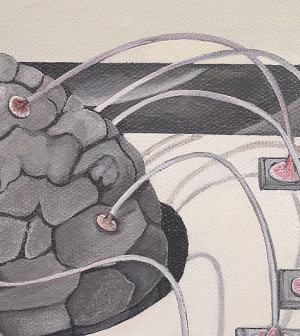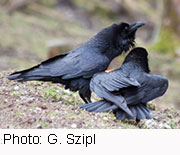- Double Mastectomy May Offer No Survival Benefit to Women With Breast Cancer
- Toxic Lead Found in Cinnamon Product, FDA Says
- Certain Abbott Blood Sugar Monitors May Give Incorrect Readings
- Athletes Can Expect High Ozone, Pollen Counts for Paris Olympics
- Fake Oxycontin Pills Widespread and Potentially Deadly: Report
- Shingles Vaccine Could Lower Dementia Risk
- Your Odds for Accidental Gun Death Rise Greatly in Certain States
- Kids From Poorer Families Less Likely to Survive Cancer
- Tough Workouts Won’t Trigger Cardiac Arrest in Folks With Long QT Syndrome
- At-Home Colon Cancer Test Can Save Lives
Like Humans, Ravens Understand There’s a Pecking Order


Joining a select group of creatures that includes humans and other primates, ravens have a keen sense of who’s who in group hierarchies that are different from their own, new research suggests.
The birds seem to understand social status and react strongly when it’s violated, even in groups of ravens they’ve never encountered before, the research showed.
Researchers already knew that ravens have different types of social bonds — including relatives, friends and partners — and that they have a social structure where some are dominant over others.
However, it wasn’t known that ravens comprehend the dominance structure between other ravens.
In this study, researchers at the University of Vienna, Austria, found that individual ravens had strong responses when they witnessed a low-ranking raven showing off to a higher-ranking raven. The reactions included gestures — such as head turns and body shakes — indicating that the ravens recognized the violation of the dominance structure among the other birds.
Importantly, this awareness extends beyond a raven’s own group to other groups, according to the study published online April 22 in the journal Nature Communications.
The findings show that, like humans and other primates, ravens are able to keep track of rank relations among other ravens, the researchers said.
Lead author Jorg Massen used the popular television series “The Sopranos” to help explain the ravens’ newly identified abilities.
“When Tony Blundetto made fun about Tony Soprano, as spectators of the show, we immediately recognized that this was inappropriate with regard to the dominance order within the Soprano family,” he said in a University of Vienna news release. “As we are not part of the Soprano family, we make this inference not by comparing our own rank relation with the two Tonys with each other, but instead we have a mental representation of the rank relation of the two that gets violated in the turn of these events.”
“As the birds in our experiment never had any physical contact with their neighboring group and could only see and hear them, these results suggest that ravens also have mental representations about others,” he noted.
More information
The Cornell Lab of Ornithology has more about ravens.
Source: HealthDay
Copyright © 2024 HealthDay. All rights reserved.










